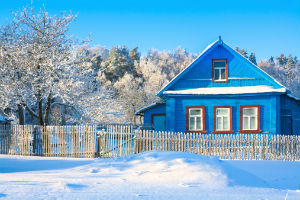Fall is an excellent time to perform home maintenance for preparing your home for winter, whether that means taking on the tasks yourself, hiring other people to perform the maintenance or a combination of the two.
To make that decision, consider:
- Whether you have the necessary tools and supplies
- If you’re physically capable of doing the work
- If you have knowledge of how the work should be done
- How you feel about climbing a ladder
- The risks that could occur if it’s cold or icy outside
- If you have enough time to complete the needed tasks before winter arrives
One task that is typically outsourced to experts is an annual furnace inspection in preparation for winter. According to Kiplinger.com, the average cost is $80 to $100 and, “If you act soon, you’ll minimize the chance of being 200th in line for repairs on the coldest day of the year.” You may feel comfortable taking on other tasks yourself. Keep reading for a comprehensive winter prep list to consider.
Winter Preparation Tasks
An article at BobVila.com breaks winter preparation tasks into five categories.
- Windows and doors:
- “Check all the weather stripping around windows and doorframes for leaks to prevent heat loss. Replace weather stripping, if necessary.”
- Lawn, garden and deck:
- “Trim overgrown branches back from the house and electrical wires to prevent iced-over or wind-swept branches from causing property damage or a power problem.”
- Tools and machinery:
- “Make sure you have an ample supply of ice melt or sand on hand for steps, walkways and the driveway.”
- Heating, ventilating and air conditioning:
- “Examine exposed ducts in the attic, basement and crawl spaces, and use a sealant to plug up any leaks.”
- Gutters, roof and drains:
- “Check for deteriorated flashing at the chimney, walls and skylights and around vent pipes. Seal joints where water could penetrate, using roofing cement and a caulking gun.”
- “By being proactive,” the author points out, “you’ll lower your energy bills, increase the efficiency and lifespan of your home’s components, and make your property safer.”
Take Precautions
Older adults produce less body heat and so are more prone to hypothermia. So stay indoors when the temperatures plunge. If you can’t, then educate yourself about the signs of hypothermia and frostbite and how to react, and dress in layers. Change into dry clothes when you come back inside and keep your house at 65 degrees or higher.
Slipping on ice is a danger, so make sure your driveway and sidewalks stay shoveled. Ask your doctor if you can do so yourself or if it makes more sense to hire someone. Wear skid-resistant boots and, if you use a cane, make sure the rubber at the tip is in good shape.
Finally, if you use space heaters, make sure that they’re positioned far enough away from curtains or anything else that’s potentially flammable.
Home Maintenance
Stock your shelves with bottled water, just in case your pipes freeze, along with ingredients for warm comfort food—and keep shelves full enough that you won’t be caught short in a blizzard.
Don’t forget about winterizing your car, making sure the tires are properly inflated, the fluids are at optimal levels, your lights work—and the heater does, too. Keep your tank filled up at least halfway throughout the winter season and have a windshield scraper and blankets in your trunk.











